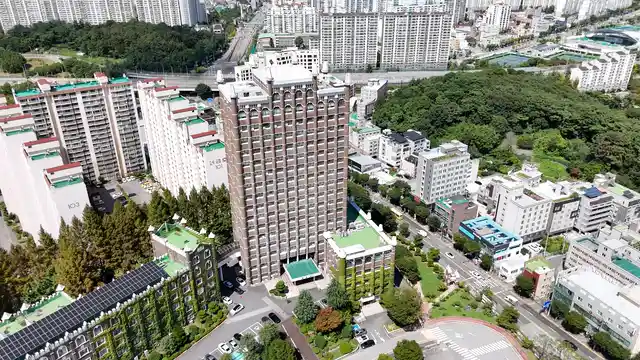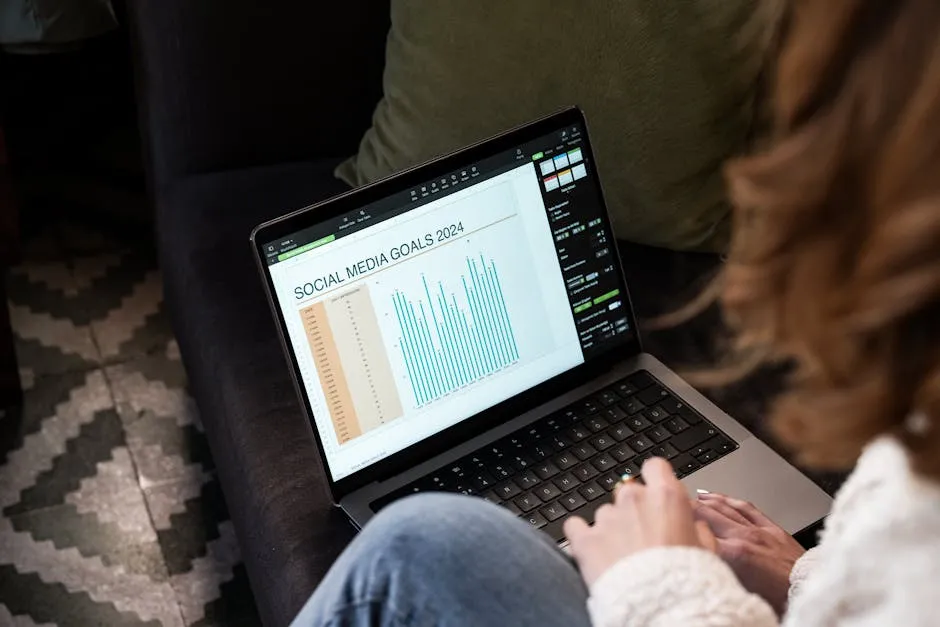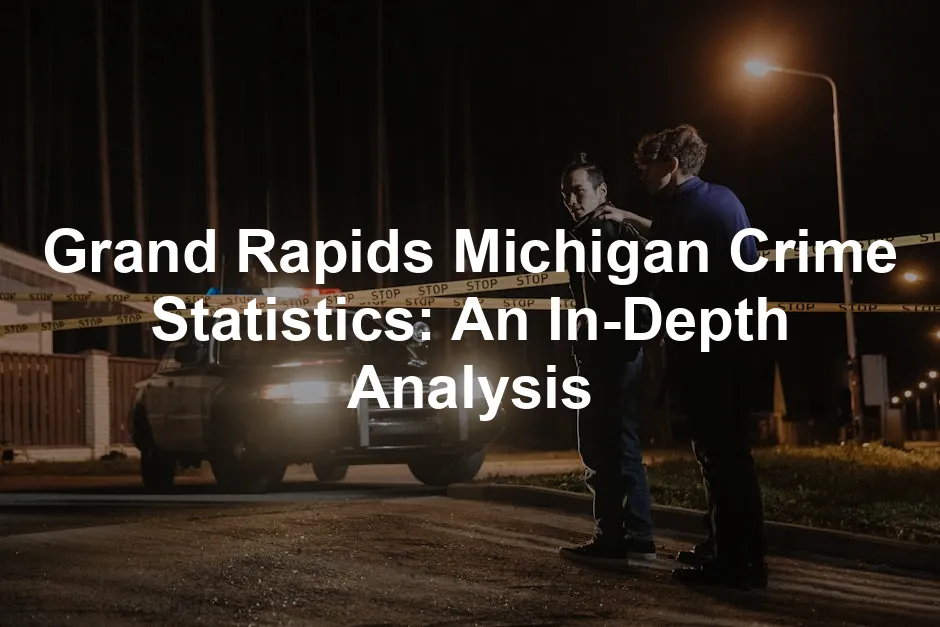Introduction
Welcome to Grand Rapids, Michigan! Nestled along the Grand River, this vibrant city is more than just a speck on the map. With a population of around 200,000, it’s the second-largest city in the state, boasting a unique blend of culture, commerce, and community spirit. Known for its craft breweries and art scene, Grand Rapids also plays host to a growing economy, driven by healthcare, manufacturing, and education sectors. However, like many urban areas, Grand Rapids faces its share of challenges, particularly regarding crime. Understanding crime statistics is crucial for residents, potential movers, and local businesses. Why? Because knowledge is power! By diving into crime trends, individuals can make informed decisions about their safety, neighborhood choices, and business locations. This article aims to shed light on the crime landscape of Grand Rapids, providing valuable insights for all. We will explore detailed statistics, year-over-year trends, and the various types of crimes that impact the community. Data for this analysis comes from reliable sources, including the FBI’s Uniform Crime Reporting (UCR) Program, local police reports, and community surveys. Together, these sources paint a comprehensive picture of crime in Grand Rapids, allowing us to understand not just the numbers but also their implications for daily life. Speaking of understanding crime, have you ever wanted to dive deeper into the psychology behind it? Check out The Anatomy of Violence: The Biological Roots of Crime. It’s a fascinating read that connects biology and crime, helping you understand the ‘why’ behind the ‘what.’
Understanding Crime Statistics
What Are Crime Statistics?
Crime statistics are numerical representations of crimes reported in a specific area over a certain period. They play a vital role in assessing public safety. By analyzing these statistics, law enforcement agencies and communities can identify crime trends and allocate resources effectively. Crimes typically fall into two categories: violent and property crimes. Violent crimes involve physical harm or the threat thereof, including murder, assault, robbery, and rape. Property crimes, on the other hand, encompass offenses where property is stolen or damaged, such as burglary, theft, and vandalism. Understanding these distinctions helps communities grasp the nature of crime they face. For those interested in the historical context of crime, I highly recommend Crime and Punishment by Fyodor Dostoevsky. It’s a classic that delves deep into morality and the human condition, providing insights that resonate even today.How Crime Rates Are Calculated
Calculating crime rates involves measuring the number of crimes per 100,000 residents. This standardization allows for fair comparisons between cities of different sizes. The FBI’s UCR Program is a primary source of crime data, providing a consistent methodology for gathering and reporting statistics. By using a per capita approach, residents can better understand the likelihood of experiencing crime in their area. For example, a city with a violent crime rate of 600 per 100,000 residents means that, statistically, one out of every 167 people may be a victim of violent crime. This method helps local authorities monitor trends and respond effectively to community safety needs. In summary, crime statistics are a crucial tool for assessing safety and understanding crime dynamics within Grand Rapids. By staying informed, residents and businesses can work together to foster a safer environment.
Overview of Grand Rapids Crime Data
Current Crime Rates
Let’s kick things off with the numbers! Recent crime statistics for Grand Rapids reveal that it’s a bit of a mixed bag. According to U.S. News, the violent crime rate sits at a striking 978.3 incidents per 100,000 people. Meanwhile, City-Data reports the property crime rate skyrocketing to 5,912 per 100,000 people. That’s like living in a pop-up horror movie, but fear not—knowledge is power! To give you a clearer picture, let’s compare these figures with state and national averages:| Statistic | Grand Rapids | Michigan | National |
|---|---|---|---|
| Total Crime | 7,838 / 100k | 3,986 / 100k | 1,998 / 100k |
| Violent Crime | 1,926 / 100k | 979 / 100k | 461 / 100k |
| Property Crime | 5,912 / 100k | 3,006 / 100k | 1,537 / 100k |
Year-Over-Year Trends
Now, onto the trends! Over the past five years, Grand Rapids’ crime rates have seen some fluctuations. From 2018 to 2022, the overall crime rate increased by 12.2%. However, don’t let that alarm you too much. The violent crime rate has actually decreased by 0.2%, which is a tiny silver lining. On the flip side, property crime has taken a steep climb, surging by 16.8%. What’s driving these changes? Experts suggest a combination of economic factors, population density, and perhaps a bit of that pesky pandemic-induced chaos.Breakdown of Specific Crimes
Let’s break it down further—what exactly are we dealing with in terms of specific crimes? Violent Crimes:- Murder: 19 incidents (9.7 per 100k in Michigan)
- Rape: 187 incidents (95.1 per 100k in Michigan)
- Robbery: 267 incidents (135.8 per 100k in Michigan)
- Assault: 1,453 incidents (738.8 per 100k in Michigan)
- Burglary: 546 incidents (277.6 per 100k in Michigan)
- Theft: 3,894 incidents (1,980.1 per 100k in Michigan)
- Vehicle Theft: 1,472 incidents (748.5 per 100k in Michigan)

Community Perceptions of Safety
Survey Results
In Grand Rapids, community perceptions of safety vary significantly. Recent surveys reveal that 52% of residents express concerns about safety, feeling uneasy when walking alone at night. Conversely, 48% of respondents consider their neighborhoods safe, citing a general sense of security. This split reflects a community grappling with its safety narrative. It’s intriguing how perceptions can differ from reality. The crime statistics show a higher-than-average crime rate, yet nearly half of the respondents feel secure. Perhaps it’s the charm of Grand Rapids that makes people overlook the darker sides. Or maybe, it’s the hope that change is on the horizon. Interestingly, discussions on community forums also highlight this dichotomy. Some residents share stories of feeling safe in their neighborhoods, while others voice their unease. This blend of perspectives creates a rich tapestry of community sentiment, showcasing varying levels of trust in local law enforcement and neighborhood dynamics.Neighborhood Crime Rates
When it comes to crime rates, Grand Rapids showcases a significant disparity among its neighborhoods. Areas like Ridgemoor, Michigan Oaks, and Westside Connection enjoy lower crime rates, often attributed to better economic conditions, community resources, and lower population density. These neighborhoods foster a sense of community engagement, which can deter criminal activity. In contrast, neighborhoods such as Black Hills, Baxter, and Oakdale report higher crime rates. Economic challenges, higher population densities, and limited access to resources contribute to these disparities. Residents in these areas often express frustration and a desire for more support and resources to combat crime. Local authorities are aware of these variations, and they continuously analyze crime data to address specific neighborhood needs. By identifying high-crime areas, law enforcement can focus resources effectively. Community programs aimed at fostering neighborhood watch efforts are essential in these regions.Public Sentiment and Law Enforcement
Public sentiment towards law enforcement in Grand Rapids is a mixed bag. Many residents appreciate the visibility of police officers, with 50% of survey respondents stating they feel the police are very visible and responsive. However, 30% believe the police respond slowly when needed, highlighting an area for improvement. Comments from community forums often reflect a desire for stronger community-police relationships. Residents want to feel heard and involved in the safety of their neighborhoods. Engaging local communities in discussions around law enforcement can lead to increased trust and cooperation. Moreover, there’s a clear link between community engagement and crime rates. When residents actively participate in neighborhood safety initiatives, crime rates tend to decrease. Programs that encourage communication between law enforcement and the community can foster an environment where residents feel empowered and involved. In summary, the perceptions of safety in Grand Rapids fluctuate widely among residents. While many feel secure, others express concern, especially in high-crime neighborhoods. Building trust with law enforcement and fostering community engagement will be crucial in shaping a safer environment for all. As Grand Rapids continues to grow, addressing these perceptions and disparities will be vital for the city’s future.
Comparison with Other Cities
Crime Rate Comparison
When it comes to crime rates, Grand Rapids doesn’t exactly have a stellar reputation. But how does it stack up against other cities? Let’s compare Grand Rapids to its neighbors and other similar-sized cities. Here’s a quick look at the crime rates per 100,000 residents in Grand Rapids, East Grand Rapids, Wyoming, and Detroit.| City | Violent Crime Rate | Property Crime Rate | Total Crime Rate |
|---|---|---|---|
| Grand Rapids | 978.3 | 5,912 | 7,838 |
| East Grand Rapids | 18 | 1,108 | 1,126 |
| Wyoming | 482.3 | 1,470.6 | 1,952.9 |
| Detroit | 2,007.8 | 2,889.7 | 4,897.5 |
For a deeper understanding of crime trends, you can explore Fremont crime statistics.
Factors Influencing Crime Rates
Several factors contribute to the crime rates in Grand Rapids. Socioeconomic conditions play a significant role. High unemployment rates can lead to desperation, pushing individuals toward crime as a means of survival. A lack of job opportunities can create an environment where crime thrives. Housing costs in Grand Rapids have skyrocketed, putting a strain on many families. When people struggle to afford basic necessities, crime becomes a more tempting option. The community’s resources also matter. Areas with strong community programs often see lower crime rates. When residents feel connected and supported, they are less likely to engage in criminal behavior. In comparison to East Grand Rapids, the socioeconomic gap is evident. East Grand Rapids boasts higher income levels and better educational resources, contributing to lower crime rates. In contrast, areas in Grand Rapids with limited access to quality education and job training experience higher crime. Overall, addressing these socioeconomic factors is crucial for improving safety in Grand Rapids. Community initiatives focused on job creation, affordable housing, and resource access can help combat crime and elevate the overall quality of life.
Addressing Crime in Grand Rapids
Law Enforcement and Community Programs
The Grand Rapids Police Department (GRPD) is the backbone of the city’s crime prevention efforts. With a focus on community policing, they prioritize building relationships with residents. By fostering trust, the GRPD encourages community members to report suspicious activities. This proactive approach helps to prevent crime before it occurs. The GRPD also participates in various community programs. Neighborhood watch initiatives are gaining traction, empowering residents to take an active role in their safety. These programs encourage neighbors to look out for one another. When communities unite, crime doesn’t stand a chance. Programs focusing on youth engagement are also vital. By supporting at-risk youth through mentorship and educational initiatives, the city aims to deter future criminal behavior. Engaging young people in constructive activities can help break the cycle of crime. Moreover, the GRPD collaborates with local organizations to enhance community resources. By addressing underlying issues, such as poverty and lack of education, they create an environment where crime has less room to flourish. In summary, the combined efforts of law enforcement and community programs are essential in addressing crime in Grand Rapids. With a united front, residents and law enforcement can work together to create a safer community for everyone.Future Projections
Looking ahead, crime trends in Grand Rapids present a mixed bag of challenges and opportunities. Experts predict a gradual decline in violent crime rates, thanks to ongoing community initiatives. The city’s current strategies emphasize collaboration between law enforcement and community members. This partnership can lead to a safer environment, especially if residents feel empowered to report suspicious activities. On the other hand, property crimes may continue to rise. Factors like economic challenges and increased population density could contribute to this trend. Local authorities recognize the need for proactive measures to tackle these issues. They are exploring innovative approaches, such as enhanced surveillance and community engagement programs. One potential initiative includes expanding neighborhood watch programs. These programs encourage residents to connect and keep an eye on each other’s homes. Building strong community ties can deter criminal activity and foster a sense of safety. Meanwhile, the Grand Rapids Police Department is committed to improving response times and increasing patrols in high-crime areas. Investments in technology also play a crucial role. Enhanced crime mapping tools can help residents stay informed. By understanding where crimes occur, individuals can take preventive measures. Ultimately, the future of crime in Grand Rapids relies on collaboration. Community involvement, law enforcement initiatives, and technological advancements are essential to creating a safer city. With a united front, residents and authorities can tackle crime effectively, ensuring a brighter future for everyone.Conclusion
In reviewing Grand Rapids’ crime statistics, several key findings emerge. The city’s violent crime rate stands at 978.3 incidents per 100,000 people, while property crime reaches a staggering 5,912 per 100,000 people. These figures not only surpass state and national averages but also highlight a pressing need for community awareness and involvement. Despite these alarming statistics, it’s essential to recognize the city’s efforts to improve safety. Local law enforcement is actively engaging with the community, promoting initiatives aimed at crime prevention. The establishment of neighborhood watch programs encourages residents to look out for one another, fostering a sense of togetherness that can deter criminal activity. Furthermore, community surveys indicate a divided sentiment regarding safety. While some residents feel secure, others express concerns about their neighborhoods. This split emphasizes the importance of ongoing dialogue between residents and law enforcement. By working together, the community can address its challenges and enhance safety measures. As Grand Rapids continues to evolve, remaining informed about local crime trends is vital. Understanding these statistics allows residents to make informed decisions about their safety and community involvement. To that end, it’s crucial to encourage community engagement in safety initiatives. Whether attending neighborhood meetings or participating in local events, residents can make a meaningful difference. In conclusion, collaboration is the key to tackling crime in Grand Rapids. By uniting residents and law enforcement, the city can work towards a safer future. Everyone has a role to play in fostering a vibrant and secure community, ensuring that Grand Rapids remains a great place to live, work, and play.FAQs
What is the crime rate in Grand Rapids compared to the national average?
Grand Rapids has a notably higher crime rate than the national average. The violent crime rate in Grand Rapids is 978.3 per 100,000 people, which is significantly above the national average of 461 per 100,000 people. Similarly, property crime rates are also elevated at 5,912 per 100,000 people, compared to the national average of 1,537 per 100,000 people. This disparity highlights the need for continuous community engagement and proactive safety measures.
Are certain neighborhoods in Grand Rapids safer than others?
Yes, crime rates vary significantly across neighborhoods in Grand Rapids. Areas such as Ridgemoor and Michigan Oaks tend to report lower crime rates, attributed to better socioeconomic conditions and community involvement. Conversely, neighborhoods like Black Hills and Baxter experience higher crime rates, prompting local authorities to focus on initiatives aimed at these areas. Understanding these dynamics can help residents make informed choices about where to live.
What can residents do to improve safety in their community?
Residents can contribute to community safety in several ways. Engaging in local neighborhood watch programs is an effective strategy. These initiatives encourage residents to keep an eye on their surroundings and report suspicious activities. Additionally, participating in community meetings fosters communication with law enforcement, allowing residents to voice concerns and collaborate on safety measures. Simple actions like securing homes and being vigilant can also make a big difference.
Where can I access Grand Rapids crime data and maps?
To access crime data and maps for Grand Rapids, visit the Grand Rapids Police Department’s official website. They provide an interactive crime map that displays recent incidents, helping residents remain informed. For detailed crime statistics, you can refer to the FBI’s Uniform Crime Reporting (UCR) Program. These resources empower residents to understand crime trends and make informed decisions about safety in their neighborhoods.
All images from Pexels




